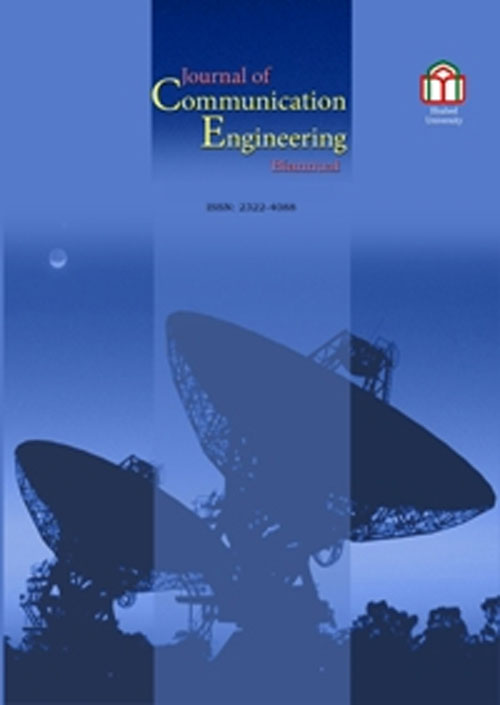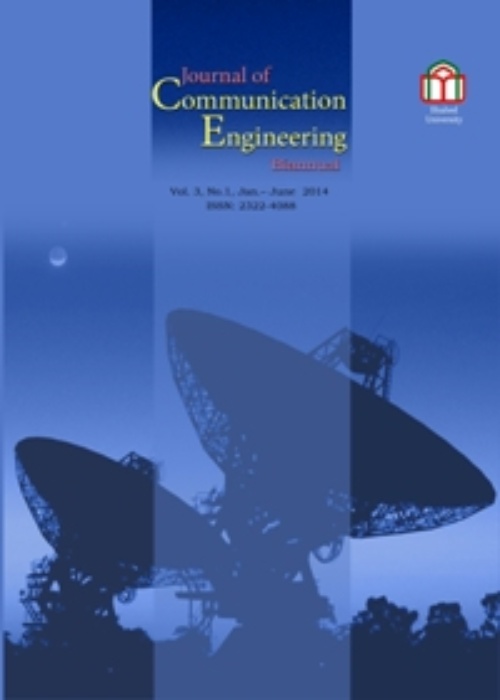فهرست مطالب

Journal of Communication Engineering
Volume:4 Issue: 2, Autumn 2015
- تاریخ انتشار: 1395/05/10
- تعداد عناوین: 6
-
-
Page 76Robust adaptive estimation of unknown parameter has been an important issue in recent years for reliable operation in the distributed networks. The conventional adaptive estimation algorithms that rely on mean square error (MSE) criterion exhibit good performance in the presence of Gaussian noise, but their performance drastically decreases under impulsive noise. In this paper, we propose a robust adaptive estimation algorithm for networks with cyclic cooperation. We model the impulsive noise as the realization of alpha-stable distribution. Here, we move beyond MSE criterion and define the estimation problem in terms of a modified cost function which exploits higher order moments of the error. To derive a distributed and adaptive solution, we first recast the problem as an equivalent form amenable to distributed implementation. Then, we resort to the steepest-descent and statistical approximation to obtain the proposed algorithm. We present some simulations results which reveal the superior performance of the proposed algorithm than the incremental least mean square (ILMS) algorithm in impulsive noise environments.Keywords: adaptive networks, distributed estimation, impulsive noise
-
Page 86Positioning service is one of Wireless Sensor Networks (WSNs) fundamental services. The accurate position of the sensor nodes plays a vital role in many applications of WSNs. In this paper, a 3D positioning algorithm is being proposed, using mobile anchor node to assist sensor nodes in order to estimate their positions in a 3D geospatial environment. However, mobile anchor nodes 3D path optimization is off the subject. Accordingly, 3D path planning is slightly involved as precision schemes to minimize error boundaries and fault probabilities on mobile wireless anchors dynamics of precision positioning. In order to analyze proposed 3D path planning schemes performance, extensive WSNs simulations have been conducted using the NS-2 network simulator. Authors had to extend NS-2s functionality to support 3D geospatial systems, features and calculations. Results indicate that path planning algorithm in discussion, achieves landmark performance and accuracy in average positioning error and percentage of positioned sensor nodes.Keywords: Mobile Anchor Node, Positioning, Wireless Sensor Networks, 3D Path Planning
-
Page 100A novel compact-sized ultra-wideband (UWB) bandpass filter (BPF) is proposed in this paper. The proposed BPF is highly selective and is able to eliminate WLAN signals from 5.15-5.35 GHz, and downlink of X-band satellite communication signals from 7.25-7.75 GHz. Generally, a multiple-mode resonator (MMR), comprised of a U-shaped line, with two high impedance stubs connected to it, and one stepped impedance resonator placed in the center of the U-shaped line is used to generate five resonate modes in the desired band (range of 3.1-10.6 GHz). Two transmission zeroes (TZs) are also placed to improve the bandage steepness. One of these TZs is with a lower cutoff frequency and the other TZ is with a higher cutoff frequency. A C-shaped open-circuited stub without adding any circuit size is parasitically coupled to the inner part of the U-shaped stub and can provide a narrow notched band at any desired frequency with appropriate bandwidth through the dimension of the parasitic element and its distance to the MMR. This C-shaped stub is used to reject WLAN signals. Furthermore, UWB passband is fully covered using asymmetric feed lines with defected interdigital coupled-lines. At the same time, another notched-band is implemented to reject X-band signals. Slots in the ground plane and input/output ports are etched to increase coupling and improve the in-band performance. The proposed BPF in the study covers UWB span completely and eliminate two bands of unwanted WLAN and X-band signals, with good linearity in the passband. A prototype filter was fabricated and its performance was measured to validate the simulation results.Keywords: Bandpass filter, multiple, mode resonator, dual notched, bands, ultra, wideband, WLAN, X, band satellite communication
-
Page 111A compact and sharp rejection UWB microstrip bandpass filter is developed using left handed metamaterials. For realizing a backward-wave propagation medium, two split ring resonator (CSRR) in the back substrate side and also one series capacitor etched in the host line, are used to produce a negative effective ε and μ, simultaneously. Moreover, in the proposed structure, two doublets parallel coupling gaps is placed at each side of the series capacitor. In comparison with the other similar filters, this structure shows a significantly wider passband due to the introduction of a cross-coupling between the feed lines (input and output) which generate four pairs of attenuation poles in the passband. On top of that, using two CSRRs and series capacitor leads to the addition of two extra transmission poles at the lower and upper edges of the filter. Consequently, a compact six-pole ultra-wide bandpass filter is designed and fabricated which exhibits extremely sharp rejection skirts around the target passband. The passband covers 3.67 to 10.42 GHz and its measured 3 dB fractional bandwidth is about 95.8%. To the best of our knowledge, the size of proposed ultra-wideband filter is more compact in comparison with known similar filters.Keywords: Complementary split ring resonator (CSRR), Doublets parallel coupling gaps, Left handed transmission line (LHTL), Metamaterial, Ultra, wideband bandpass filter (UWBF)
-
Page 122A four-way power divider/power combiner using substrate integrated waveguide (SIW) and microstrip lines is proposed and investigated. The proposed power divider consists of a double-layer substrate with a bottom layer including an SIW T-junction and a top layer including a microstrip network. This microstrip network consists of a modified Gysel power divider which provides a high isolation between output ports by using two grounded resistors. Meanwhile, this modified Gysel power divider maintains high power-handling advantage over Wilkinson power divider. A transition between the SIW T-junction and microstrip network is realized by etching two rectangular slots on the middle metal layer. The even-odd mode method is used to analyze the presented structure. A prototype of the proposed power divider is designed, simulated, and fabricated. The results show that the return loss of the input port is better than 12 dB over 8.43 to 10.57GHz. Also, the output return losses and isolation are better than 10.5 dB over the whole bandwidth.Keywords: Gysel power divider, high isolation, high power, power combiner, substrate integrated waveguide (SIW)
-
Page 132In this pare, a wideband three-order bandpass filter (BPF) is proposed. The proposed wideband filter is designed using the substrate integrated waveguide (SIW) structure by loading T-shape slots. A BPF with two resonators is formed by etching T-shape slots with different size on the top metal plane of the SIW structure. The filter is investigated with the theory of coupled resonator circuits. The T-shape slots, etched on the SIW structure, are used to form up a new multiple-mode resonator (MMR) in order to achieve a wide passband of operation while keeping the overall size of the proposed filter to be much compact. The design procedure as well as design curves of the filter are given and discussed here. Compared with some other reported BPFs with SIW technique, the presented BPF using the SIW structure loaded by T-shape slot has great improvements on size reduction and selectivity. In order to prove the validity, the proposed wideband SIW BPF on a single layer printed circuit board (PCB) is designed and experimentally examined. The measured results show that the filter achieves an insertion loss of 1.1 dB at 6.4 GHz and a return loss of higher than 21 dB. The proposed filter has a pass-band covers 5.1 to 7.99 GHz and its simulated and measured 3 dB fractional bandwidth is about 44.3%. The measured results are in a good agreement with the simulated results.Keywords: microwave filter, substrate integrated waveguide (SIW), wide bandpass


